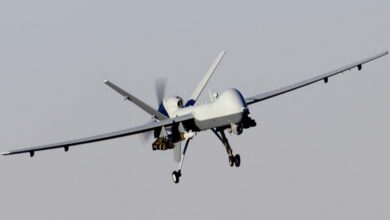Drone Revolution: The Ukraine War Reshapes U.S. Military Priorities

The U.S. military is undergoing a major transformation — the most significant since the end of the Cold War — with a plan to equip every combat brigade with around 1,000 drones and retire outdated conventional weapons.
-
An American Historical Solution for the Ukraine Crisis: The Post-War Berlin Model
-
Trump and Ukraine’s Nuclear Plants… Bigger Than an Acquisition Plan
The new strategy, developed after extensive testing at the Hohenfels training ground in Bavaria and other military sites, is based on lessons learned from the war in Ukraine, where small drones have proven highly effective in shifting the balance on the battlefield.
If implemented, the plan would see the ten active combat brigades relying primarily on drones for reconnaissance, supply transport, and offensive operations.
To leverage Ukraine’s experience, U.S. officers interviewed Ukrainian troops and consulted with contractors who had developed innovative drone applications.
-
Weapon Tests Precede Russian Official’s Visit… Kim’s Messages to Allies and Enemies
-
Ukraine’s allies rally to support it… ‘A show of presence’ against Putin and Trump
In an interview with the Journal, Colonel Donald Neal, commander of the 2nd Armored Division, stressed the need for mass production and battlefield deployment of drones, noting that their use had previously been limited. Integration efforts were evident during training in February, when a battalion from the 10th Mountain Division engaged a simulated enemy using scenarios inspired by Ukrainian tactics.
During the exercise, drones faced unexpected challenges — ice forming on their propellers, weakened batteries in freezing temperatures — requiring frequent recharging by soldiers.
-
Ukraine ‘Truce’: Russia Responds to US Proposal
-
Ukraine after the Suspension of U.S. Aid: Implications and Options
Despite the role of artillery, armored vehicles, manned aircraft, and other traditional systems in the Russia–Ukraine war, drones have been the true game-changer due to their low cost, swarm-attack capability to overwhelm defenses, and ability to stream live video to rear command, making concealment on the battlefield increasingly difficult, analysts told the paper.
Retired General Jack Keane, former Army Vice Chief of Staff, called the shift “a move toward the era of drone warfare,” allowing for precise and rapid targeting of troops, tanks, and command centers.
-
Ukraine and Russia in the “State of the Union”: A Sign of Peace and Readiness for Dialogue
-
Washington and Kyiv: Zelensky Bets on “Behind-the-Scenes” Agreements
The plan extends beyond drones: it includes enhanced communication among troops via phones and tablets, the development of anti-drone systems, and a $3 billion investment in electronic warfare.
The total cost of the plan is $36 billion over five years, to be funded by phasing out outdated systems such as Humvees, ineffective M10 light tanks, retiring Apache helicopters, and reducing the civilian workforce.
These changes require congressional approval, particularly amid budget-cutting efforts led by the “Government Efficiency” initiative under Elon Musk’s leadership.
-
U.S. Support Halted: Dangerous Scenarios for Ukraine in Its Fight against Russia
-
Ukraine Faces an Uncertain Future after a Clash Between Zelensky and Trump
General Randy George, the Army Chief of Staff, stated that the goal is “to spend smarter without requesting additional funding.” The military has already begun equipping three battalions (each with 3,000–5,000 troops) with the new systems and plans to complete the transition across the force within two years.
Similarly, the U.S. Marine Corps has retired its tanks in favor of small missile-equipped combat units capable of operating across Pacific islands to counter the Chinese threat. However, the Army still plans to acquire new tanks and long-range missiles to bolster its presence in Asia and Europe.
-
Ukraine without America: Zelensky Talks About “Slim Chances” of Survival
-
“Strategic ‘Toretsk’ in Russian Hands… Ukraine Faces Supply Line Crisis”
The U.S. defense industry faces the challenge of expanding its advanced tech production base, especially given the ban on Chinese-made drone components — despite Ukraine’s success in producing two million drones annually using such parts.
This “military transformation initiative” represents a swift American response to modern battlefield developments, with a unique focus on low-cost, replicable technologies that could define the future of conventional warfare.












